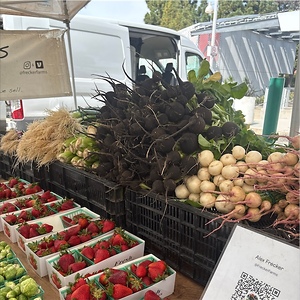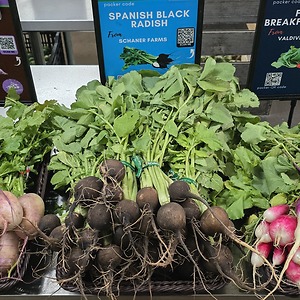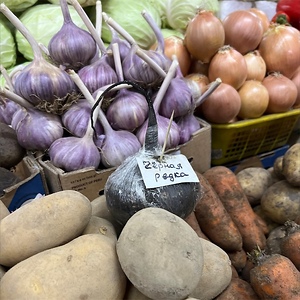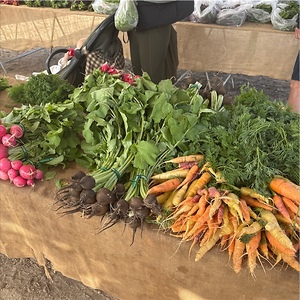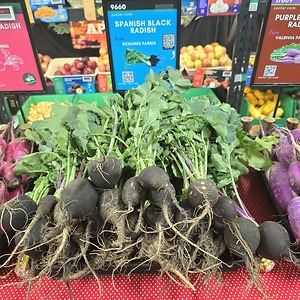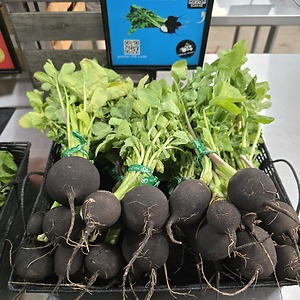


Black Radish
Estimated Inventory, 25 lbs : 0.88
This item was last sold on : 07/13/25
Description/Taste
Black radishes are a larger radish variety and range in size and appearance, depending on the specific type. The first type, Round Black radishes, average 7 to 10 centimeters in diameter and have a tapered, curved shape, sometimes ending in a small taproot. The second type, Long Black radishes, have an elongated, cylindrical shape, averaging 17 to 20 centimeters in length. Both varieties are encased in a black to dark brown skin that is thick, rough, and coarse. Underneath the surface, the flesh is bright white, firm, crisp, and moist with a fibrous, dense consistency. Black radishes are known for bearing an earthy, spicy, bitter, and pungent flavor when raw and have a sharper taste than other radish varieties. When cooked, the crunchy flesh softens, and the flavor mellows, developing subtly sweet peppery undertones.
Seasons/Availability
Black radishes are available year-round, with a peak season in the winter through early spring.
Current Facts
Black radishes, botanically classified as Raphanus sativus var. niger, are an ancient, rare variety belonging to the Brassicaceae family. The annual plants are a winter heirloom cultivar and were once one of the most widely cultivated varieties in Europe. Black radishes provided vital nutrients during the barren winter months of the Middle Ages, and Europeans heavily relied on the root’s cold tolerance and extended storage capabilities as a filling food source. As new radish varieties were introduced in the 19th and 20th centuries, the fibrous, slow-growing variety was replaced for smoother, colorful, and easy-to-market radishes. Black radishes are also known as Black Spanish radish, Gros Noir d’Hiver, Black Mooli, and Erfurter radish. In the modern-day, Black radishes are challenging to find and are primarily reserved to farmer’s markets, home gardens, and specialty grocers. There are two main types of Black radishes, one with a round, tapered shape, and the other bearing an elongated, cylindrical shape, and both types can be used interchangeably in raw and cooked culinary applications.
Nutritional Value
Black radishes are an excellent source of vitamin C to strengthen the immune system and provide potassium, iron, magnesium, and vitamins A, E, and B. The roots also contain glucosinolate, a phytonutrient that can boost digestion and liver detoxification. In traditional medicines of Europe and Asia, Black radishes have long been used to stimulate bile function and improve the health of the gallbladder.
Applications
Black radishes have a sharp, spicy flavor reminiscent of horseradish and are suited for both raw and cooked applications. When used fresh, the flesh should be thinly sliced, chopped, or shredded and combined with tart and sweet ingredients to balance flavors. Shredded Black radishes can be tossed into salads, stirred into grain bowls, used as a topping for tacos, or pressed and mixed into healthy juices. It is important to note that the skin contains most of the spicy, peppery flavor. The skin is edible, but if a milder taste is desired, it can be peeled before eating. Black radishes can also be roasted, braised, fried, and sauteed. When cooked, the roots can be mashed and mixed with cheeses or sour cream to make a dip for appetizer plates or spread over roasted meats. Black radishes can also be stirred into potato and egg-based dishes, sliced thin and fried into chips, or diced and tossed into soups and stews. Beyond cooking, Black radishes are pickled for extended use and are sometimes utilized as a spicy element in kimchi. Black radishes pair well with herbs such as chervil, thyme, parsley, chives, and mint, apples, pomegranates, arugula, peas, carrots, celery root, truffles, roasted meats, including steak, pork, and poultry, and seafood. Whole, unwashed Black radishes will keep 1 to 2 weeks when stored in a perforated plastic bag or wrapped in newspaper in the refrigerator.
Ethnic/Cultural Info
Black radishes were considered sacred in Ancient Egypt and were widely used in both culinary and medicinal applications in conjunction with garlic and onions. Drawings of radishes found in Egyptian tombs can be traced back to 2000 BCE, and written texts from the Greek historian Herodotus also mention that Egyptians thought that radishes contained high energy due to their spicy, warming flavor. Pharaohs capitalized on this belief, and Black radishes were frequently fed to workers building the pyramids to sustain and increase energy levels. Egyptian workers typically ate two meals a day, and while breakfast consisted mostly of bread and beer, their evening meal incorporated radishes, other vegetables, meats, and fruits. Experts believe radishes were consumed at almost every meal for pyramid workers, and the roots were also utilized medicinally to treat respiratory problems and topically to heal bug bites. In addition to using the root’s fresh, radish seeds were processed into oil, used for culinary, medicinal, and cosmetic applications.
Geography/History
Black radishes were first cultivated in the Eastern Mediterranean and are believed to be a relative of the wild radish, which was found in regions of Eastern Europe and Asia. The thick, fibrous roots became well-adapted to cold, winter climates and were spread to North Africa and the Western Mediterranean, where they were used by the Ancient Egyptians and Greeks. Black radishes were introduced to the rest of Europe during the Middle Ages and were one of the primary root vegetables grown for their nutritional content, increasing their popularity in Europe through the 19th century. The roots were also introduced to the New World and were cultivated in home gardens by the 19th century. Over time, Black radishes faded from cultivation as new, milder, and softer radish varieties were developed, and the cultivar eventually became a mostly forgotten variety. Today Black radishes are rare and are found through farmer’s markets and specialty grocers worldwide. The roots are also grown on a smaller scale as a novel variety in home gardens.
Featured Restaurants
Restaurants currently purchasing this product as an ingredient for their menu.
| The Kitchen at MCASD | La Jolla CA | 619-880-8719 |
| Pendry SD (Provisional) | San Diego CA | 619-738-7000 |
| Webbcreationfood LLC | San Diego CA | 619-829-9194 |
| Fairmont Grand Del Mar | San Diego CA | 858-314-1975 |
| Lilo | Carlsbad CA | 619-385-0914 |
| Park Hyatt Aviara (Ember & Rye) | Carlsbad CA | 760-448-1234 |
| Cal A Vie | Vista CA | 760-945-2055 |
| Dija Mara | Oceanside CA | 760-231-5376 |
| Mothership | San Diego CA | 858-342-3609 |
Recipe Ideas
Recipes that include Black Radish. One
| A Brown Table |
|
Green Chickpea Salad, Pickled Black Radish, and Turmeric Root |



